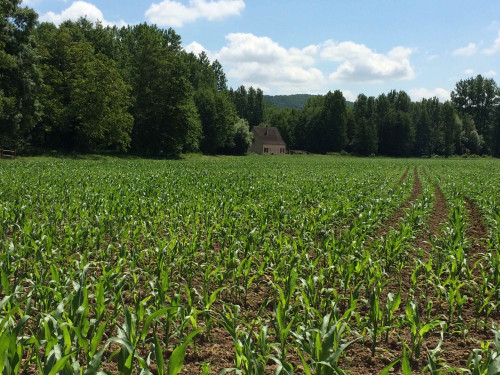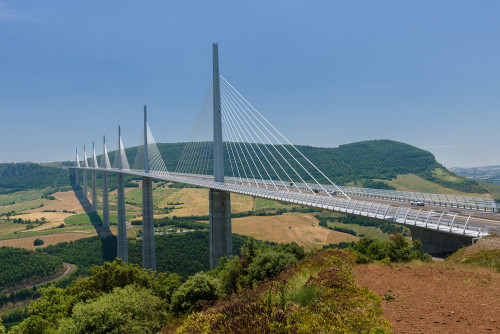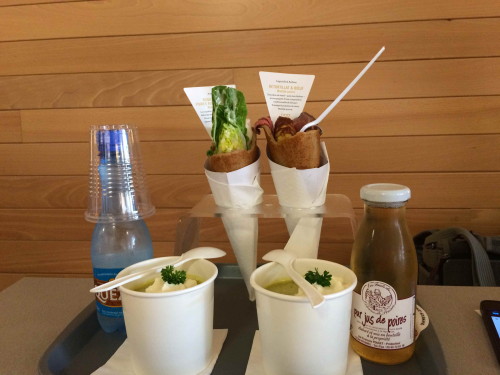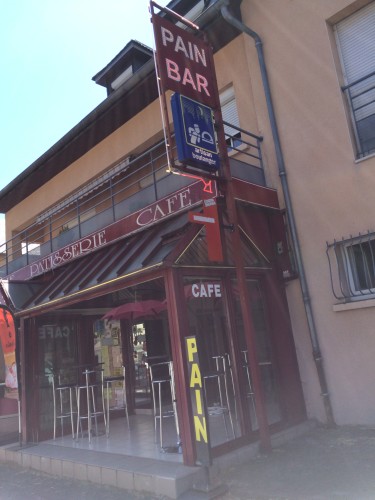The trains in Europe are great. However, they don’t serve some of the smallest towns in France. To visit those, you’ll need to rent a car. We’ve rented cars to travel around Europe twice, and here is our collective wisdom:
Rent the smallest model that will fit you, your traveling companions, and your luggage. If necessary, downsize your luggage to fit a smaller car. Our Peugeot 308 just barely fit on a one-lane bridge, and we needed to worry about its size for parking spaces.
Most rental cars in Europe are manual transmission. You can find automatic transmission cars, but prepare to pay more to rent them.
Rent a diesel car. The mileage is better, and diesel or gasoil is cheaper than gasoline in Europe.
Download a map application for your cell phone that can work offline. This will be helpful in the hinterlands, and will reduce your need for excess data plan for your cell phone. Those megabytes add up fast.
Learn to think in metric. Distances are in kilometers instead of miles, and fuel is sold in liters rather than gallons. One kilometer (km) is 0.6 miles, so 10 km is about 6 miles. One gallon is 3.8 liters. So if you buy gas at 1.40 Euros per liter, that’s 5.32 Euros per gallon. A 50-liter tank of gas (just over 13 gallons) will set you back 70 Euros. Consider the cost of gas carefully when you think about renting a car.
Also consider the cost of tolls. France’s autoroutes are highly tolled. The drive from Montpellier to Lyon (about 300 km/180 miles) set us back over 20 Euros.
Although renting a car in Europe is not cheap, it will allow you more flexibility in your travel times and destinations. It also gets you away from the tourist traps and into the countryside.
Jun 15
Words from the Wiseacres
Permanent link to this article: http://ediblethoughts.com/2015/06/15/words-from-the-wiseacres/
Jun 13
More on Rest Stops: The Millau Viaduct
“Why a duck? Why a no chicken?” (Chico Marx, The Cocoanuts)
The Millau Viaduct is the highest bridge in the world, and the tallest structure of any kind in France. It opened for traffic in 2005. It’s an amazing bit of engineering and good-looking to boot.
We had lunch at the rest stop/visitors’ center just north of the viaduct on our way to Lyon. The restaurant had an interesting wrap-type option called Capucins, based on the headdresses Capucin monks wore. A thick pancake batter is scooped into a mold and is baked in the shape of a cone. The cone is then filled with meat or other fillings. I got a Roquefort Capucin with lettuce, walnuts, and pear chutney. Julian got a roast beef one. We augmented the Capucins with gazpacho. Julian said in the southern US Capucins would be named after other conical headdresses: Ku Klux Kones.
Permanent link to this article: http://ediblethoughts.com/2015/06/13/more-on-rest-stops-the-millau-viaduct/
Jun 13
Feeding Between the Lines, part two
We’re attending a birthday party tonight for our friend who is intolerant of onions, garlic, and the like. As you may know from my original post of this title, our friends have a plethora of allergies, intolerances, and aversions. My philosophy is to make something that the maximum amount of people can eat. So I made a beet salad with a simple vinaigrette: olive oil, red wine vinegar, salt, black pepper, and a little dried oregano. I’ll put a little fresh oregano on top of the salad before we go tonight. We’re also making our famous mint sauce for the barbecued lamb that our host is making. Fresh mint, red wine vinegar, and a little sugar; it doesn’t get any easier.
Permanent link to this article: http://ediblethoughts.com/2015/06/13/feeding-between-the-lines-part-two/
Jun 12
Copper River Salmon Gemisch
The arrival of Copper River Salmon is one of those big deal events for some in Seattle. The flesh of this salmon is higher in fat than fish from other origins, particularly farm-raised. The fish have to lay on extra fat to survive the long trip to their hatching place to spawn. More fat equals more flavor. In mid-May the first fish get flown on a special Alaska Airlines flight. (Too bad they’re dead already and can’t consume peanuts on the way down.) The price is exorbitant at first, but eventually it falls to affordable. QFC, a local chain, had it on sale this week for $9.99 per pound. I picked up a slab on the way home from work for dinner.
Our usual recipe is to plank the salmon with garlic, onion, brown sugar, orange rind, and basil. Unfortunately, I forgot to pick up an orange along with the fish. Plan B was to plank it and serve it with a mustard vinaigrette over salad. This is an adaptation of a recipe I found in a book called Savory Flavors with Wood (Nature’s Cuisine, 2004). The text of the book was written by an acquaintance of mine, Judith Dern. The “secret ingredient” in the vinaigrette was suggested by our French professor. It adds just a wee bit of umami action to the dressing.
Salmon with Mustard Vinaigrette
1/4 cup olive oil
3 tbsp. white wine vinegar
1 tbsp. Dijon mustard
Secret ingredient: a few drops Thai or Vietnamese fish sauce (I used Red Boat)
1 lb. salmon filet
salt and freshly ground pepper to taste
2 tbsp. chopped fresh basil
3 cups kale
cucumber and red bell pepper
Oil a cedar or alder plank big enough to hold the piece of fish. Preheat grill. Whisk the oil, vinegar, mustard, fish sauce, salt, and pepper together until smooth. Place the fish on the plank and drizzle with some of the vinaigrette. Roast fish on plank on medium-high (400°) until fish just starts to flake when tested with fork. While the salmon’s on the grill, tear the kale into bite-size pieces and divide between two salad plates. Add cucumber, red bell pepper, or other vegetables as desired. Serve salmon atop the kale salad. Drizzle some of the remaining vinaigrette over the salad. Serves 2-3.
We had some leftovers that Julian turned into salmon salad the next day. He chopped in some red bell pepper, moistened it with a little extra vinaigrette, and threw in some capers. It wasn’t the tidiest lunch, but it certainly was tasty.
Permanent link to this article: http://ediblethoughts.com/2015/06/12/copper-river-salmon-gemisch/
Jun 11
Glutenous Maximus
It’s hard to think of a culture more gluten-centered than the French. Baguettes are a daily tradition, as are pastries, croissants, cakes, biscuits (cookies in the US), and tarts. Then you have flour-thickened sauces such as bêchamel and velouté. So it was a bit of a surprise to find a selection of gluten-free fad diet books in a bookstore in Albi. Most of them were translations of American books such as Wheat Belly. From my observations, the fad hasn’t caught on amongst most French people.
About the time I first wrote this post, Julian got an email from our friend whose older daughter has celiac disease. They will be visiting friends in Paris later in the summer, and they’re obviously anxious about gluten-free dining. Yogurt and fruit are probably the best bet for breakfast. Gluten-free options do exist, but it may take more hunting.
Permanent link to this article: http://ediblethoughts.com/2015/06/11/glutenous-maximus/
Jun 11
Double-Take Time
Permanent link to this article: http://ediblethoughts.com/2015/06/11/double-take-time/
Jun 05
Quenching One’s Thirst
The weather in Amsterdam and Paris was moderate, with highs in the 60’s. So it was a bit of a shock when the temperature upon our arrival in St. Cirq-Lapopie was 86° (30°C). The climate in southern France, even in the high country, is dictated by the warm Mediterranean rather than the icy Atlantic. We spent a lot of time in the afternoons attempting to keep hydrated.
My philosophy of fluids to quench thirst is simple: Water is best, followed by something with a bitter edge. For example, beer is better than wine to deal with thirst. Grapefruit juice does a better job than other juices. Iced tea that is unsweetened and unflavored is better than sweet tea or soda. Gin and tonics were tailor-made to deal with thirst in the tropics.
As persnickety as the French are about their food and wine, you’d think they’d be the same way about soft drinks. You would be dead wrong. We ordered “limonade” in Albi. Instead of lemon juice squeezed into water with a little sugar, we got something more like Sprite.
In numerous places we asked whether the iced tea was sweetened or flavored. The answer was universal: sweetened peach-flavored tea, usually from Nestlé. Julian got some, and it was dreadful. Iced tea should be black, unsweetened, and unadulterated with any tutti-frutti flavors. Anything else and you may as well be drinking soda.
If you really want to slack your thirst, stick to water or slightly bitter beverages. Not only will you feel better, you may save some calories if the choice is between water and soda.
Permanent link to this article: http://ediblethoughts.com/2015/06/05/quenching-ones-thirst/
Jun 04
Moving Around When Moving’s an Issue
France has some policies that are more progressive than the United States, but there is one area that lags far behind–accommodating persons with mobility issues. Elevators in many buildings are non-existent or won’t fit a standard wheelchair. Smaller Métro stations in Paris don’t have elevators or escalators. In most French restaurants, “les toilettes” are down a narrow spiral staircase below the dining area. I watched numerous elderly folks from a tour bus make their ways painfully toward the restrooms in one restaurant in Beynac. And this was a modern building, not one of the Medieval retrofits in town. In fairness to our hosts, we have seen handicapped parking spaces around Paris and in the villages.
My advice to travelers with mobility or balance issues is to call in advance and make sure you can access facilities. If you’re staying at a hotel, the concierge should be able to steer you towards places that can accommodate your needs. This can save a lot of hassles.
Permanent link to this article: http://ediblethoughts.com/2015/06/04/moving-around-when-movings-an-issue/
Jun 04
Cornfields in France
 Corn is not a major ingredient in French cuisine except in the Basque country. So how come we saw corn fields in the Dordogne Valley? Two words: Foie gras. Corn is a key component of overfeeding ducks and geese to produce the fatty liver that’s such a delicacy in the region. Julian had some duck foie gras the night we spent in Domme. I’ll admit it was good. Would I eat it on a regular basis? No, courtesy of its calorie content and cost.
Corn is not a major ingredient in French cuisine except in the Basque country. So how come we saw corn fields in the Dordogne Valley? Two words: Foie gras. Corn is a key component of overfeeding ducks and geese to produce the fatty liver that’s such a delicacy in the region. Julian had some duck foie gras the night we spent in Domme. I’ll admit it was good. Would I eat it on a regular basis? No, courtesy of its calorie content and cost.
There is a human analog to foie gras that may also involve corn. Excessive consumption of high-fructose corn syrup with overindulgence of calories may contribute to non-alcoholic fatty liver disease in people. The fructose can be converted to fat, which can build up in the liver because it can’t be exported to the blood fast enough. So in essence, you may be developing your own foie gras. Something to consider next time you stop for a large soda.
Permanent link to this article: http://ediblethoughts.com/2015/06/04/cornfields-in-france/
Jun 04
Pictorial Observations
It’s a good thing we came here during the age of the digital camera. Julian would have gone broke with all the pictures he’s taken on this trip if he still used film. Photoshop has also saved him from over- or underexposed shots. He’ll be spending many hours after we get home tweaking his photos for public consumption. Even though my camera of choice is my phone, I’ve also profited from the digital era. It boggles my mind that I can have so many pictures on a device that fits in my purse.
Permanent link to this article: http://ediblethoughts.com/2015/06/04/pictorial-observations/





Recent Comments